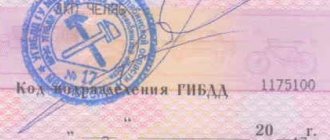Who can enter information about the new owner into the PTS?
The law does not have clear instructions about who exactly should enter information about the new owner of the vehicle. Ownership passes to the buyer upon signing the purchase and sale agreement. If the documents are signed, the seller may not deregister the car at all. The obligation for such actions occurs in cases of sale of the vehicle abroad or during disposal.
After signing the contract, the buyer of the car becomes its owner, which means that the next step is making changes to the traffic police (GAI). Motorists are given 10 days to do this. After this period, the new owner will be put on the wanted list, so you should not delay in informing the relevant services.
At the moment when a car changes owner, any of the parties to the transaction can enter information about the change of owner in the title, but practice shows that more often the buyer does this.
Paragraphs 21 and 22 of the joint order of the Ministry of Internal Affairs No. 496, the Ministry of Industry No. 192 and the Ministry of Economic Development No. 134 indicate the general requirements for filling out the lines and fields of the vehicle passport. You can enter information about the new owner yourself or using a printer in the traffic police.
The only requirement for filling out the fields in writing is that the entered text must be easy to read, and the names of individuals and legal entities must not have abbreviations other than generally accepted ones.
Both methods are correct, but it is worth considering that when entering information “by hand,” there is a risk of making a mistake or blot. If an error is detected, the vehicle passport must be replaced.
Another equally important point is the presence of signatures of the parties to the transaction , and in the case of relations involving legal entities, also seals.
The place in the title has run out, there is nowhere to add the new owner. What to do?
The absence of free fields in the PTS to indicate the new owner cannot give rise to negative consequences for the owner, since registration of a vehicle is only a consequence of the transaction, and not the basis for the emergence of civil rights and obligations.
In accordance with paragraphs 1 and 2 of Article 209 of the Civil Code of the Russian Federation, the owner has the rights to own, use and dispose of his property. The owner has the right, at his own discretion, to take any actions in relation to his property that do not contradict the law and other legal acts and do not violate the rights and legally protected interests of other persons, including alienating his property into the ownership of other persons, transferring to them, while remaining the owner, the rights possession, use and disposal of property, pledge property and encumber it in other ways, dispose of it in any other way.
According to paragraph 2 of Article 1 of the said Code, citizens (individuals) and legal entities acquire and exercise their civil rights of their own will and in their own interest. They are free to establish their rights and obligations on the basis of the contract and to determine any terms of the contract that do not contradict the law.
Civil rights may be limited on the basis of federal law and only to the extent necessary in order to protect the foundations of the constitutional system, morality, health, rights and legitimate interests of other persons, to ensure the defense of the country and the security of the state.
The Civil Code of the Russian Federation and other federal laws do not contain rules limiting the powers of the owner to dispose of a vehicle in cases where it is not indicated in the PTS.
Consequently, when alienating vehicles that, by law, do not belong to real estate, the general rule enshrined in paragraph 1 of Article 223 of the Civil Code of the Russian Federation applies: the ownership right of the acquirer of the thing under the contract arises from the moment of its transfer, unless otherwise provided by law or agreement.
As follows from the content of Part 3 of Article 15 of the Law “On Road Safety”, vehicle registration is carried out to allow vehicles to participate in road traffic.
Transactions with vehicles are not subject to registration with government authorities. Registration of a vehicle with the traffic police does not establish civil rights and obligations, but is the vehicle’s permission to participate in road traffic (Article 15 of the Federal Law “On Road Safety”). Thus, registering a vehicle with the traffic police does not in any way affect the transfer of ownership of the car.
In accordance with Order of the Ministry of Internal Affairs of Russia dated 08/07/2013 N 605 (as amended on 06/26/2018) “On approval of the Administrative Regulations of the Ministry of Internal Affairs of the Russian Federation for the provision of public services for the registration of motor vehicles and trailers for them” (Registered with the Ministry of Justice of Russia on September 27. 2013 N 30048) a duplicate vehicle passport is issued to replace a lost or unusable vehicle passport.
A PTS in which all columns are filled in is unsuitable for further use even if the owner changes and must be replaced.
The participation of the previous owner in carrying out registration actions is not required.
The registration authorities of the State Traffic Safety Inspectorate are required to issue a new PTS upon presentation by the owner of a document confirming ownership (sale and purchase agreement, donation, inheritance documents, etc.).
Addition!
Cases of refusal to register a vehicle on the basis of Order of the Ministry of Internal Affairs of Russia N 496, the Ministry of Industry and Energy of Russia N 192, the Ministry of Economic Development of Russia N 134 of June 23, 2005 (as amended on November 11, 2015) “On approval of the Regulations on vehicle passports and vehicle chassis passports” have become more frequent ( Registered with the Ministry of Justice of Russia on July 29, 2005 N 6842).
Traffic police officers refer to paragraph 16 of the Order.
The order establishes: “If it is impossible to further use the passport due to its deterioration or the filling in of all its details regarding the change of ownership of the vehicle or chassis by the State Traffic Inspectorate unit at the place of the last transaction aimed at terminating and acquiring ownership of the vehicle or chassis, in replacement of the used passport a duplicate passport is issued, in which in the section “Special information”
The last transaction is considered to be a purchase and sale transaction by the current owner, and not by the previous owner. The property rights of the previous owner ceased from the moment the transaction was completed. Thus, refusal of registration actions with reference to clause 16 of the Order is not permissible.
Defender of motorists, Chairman of the Committee for the Protection of the Rights of Car Owners
Kirill "Medved01" Formanchuk
How to correctly replace information about the old owner?
Despite the fact that all fields and columns of the corresponding section of the passport have informative signatures about what information should be contained in each of them, you should provide instructions for filling out the PTS and talk about the features.
So, how to correctly enter the new owner into the PTS.
- The first entry point is the column “Name (full name) of the owner.”
It contains information about the new owner of the car. The surname, first name and patronymic, as well as the name of the organization in the case of a purchase by a legal entity, must be indicated in the same way as in an identification document (passport of a citizen of the Russian Federation or another one provided for by law) or company papers. Problems may arise for people who fill out the PTS with their own hands. Make sure that there are no blots or errors in the document. - In the “Address” line, information about the registration address of the new owner or the legal address of the LLC is entered.
- In the “Date of sale” field, enter the day, month and year of the transaction under the purchase and sale agreement. This is an important point, therefore, at the stage of preparing transaction documents, it is recommended to leave the date open in order to fit it into the day of the transaction itself.
- The item “Document of ownership” must contain information about the agreement that confirms the transaction (purchase and sale agreement, gift agreement or other papers). It often happens that this line has the entry “Other documents”. This is not an error, but it is best to indicate in the PTS all information related to the transaction.
Below in the photo you can see an example of how to correctly enter a new owner into the title:
This is followed by the signatures of the parties in the appropriate places in the document and a seal, if required.
There are situations when the PTS does not have room for information about the new owner. The problem can be solved simply - at the re-registration stage, the document is replaced with a duplicate with a note about the last owner.
How to add a new owner
The new owner is the buyer himself and, it would seem, what problems and questions may arise here, but there are nuances. Many new owners do not know whether they can enter data into the form themselves or whether they must resort to the services of traffic police officers.
You can simply enter yourself into the PTS by hand. The procedure is extremely simple:
- First, the surname, first name and patronymic are entered;
- then permanent registration address;
- date of purchase of the car;
- information about the document of ownership, which is the purchase and sale agreement;
- at the last stage, the signature of the new owner is entered in the appropriate column.
In some cases, the traffic police may enter data into the document in printed form, leaving only the signature column blank. But most often the buyer will be denied such a service, so it is better to write down all the necessary information in the appropriate lines yourself.
Can I make changes myself?
No one is immune from mistakes. Both the buyers themselves and the MREO employees can fill out the fields incorrectly. The buyer and seller may confuse the signature places, and when entering data in print, the letters of the first or last name may often be distorted.
Any shortcomings can be corrected only in the traffic police departments where the registration will be carried out or where the car was previously registered (errors can be detected after the vehicle is registered).
A request to correct errors or typos can only be made by the real owner or his representative with a notarized general power of attorney. It must indicate that the power of attorney was issued to correct inaccurate data and the principal has the right to make corrections.
When contacting the MREO, you will need to have with you the civil passport of the owner of the car and a registration certificate. The applicant fills out a form with a request to make appropriate changes to the document. The registrar accepts the application, after which all that remains is to wait for the result. Typically, the procedure takes only 1-2 days, but often owners have to wait several weeks for the final result.
If the name is indicated, but there is no traffic police stamp (traffic police)
Due to the fact that citizens have the opportunity to independently enter data into the PTS, situations where the document does not have a traffic police seal are not uncommon. In simple words, such cases indicate one thing - the car is not registered with the traffic police and is not assigned to this person, although the owner’s full name is entered. In accordance with clause 33 of Order of the Ministry of Internal Affairs No. 1001 of November 24, 2008 (as amended on February 13, 2015) “On the procedure for registering a vehicle,” the new owner is allocated 10 days for this procedure.
The first step is to ask the seller about the reasons for this action. This happens if the vehicle is purchased for subsequent resale. By and large, this does not matter, since when deregistering a sold car, the former owner provided a written document containing the details of the new owner. This means that the relevant authorities already have information about who currently owns the car.
However, in various regions of Russia there are still cases when a buyer experiences difficulties in registering a vehicle due to the fact that the previous owner did not perform such an action. This procedure on the part of the traffic police is not justified in the form of laws or regulations.
The purchase and sale agreement is a legal confirmation of the transaction. The most important thing is that the car is not on the list of stolen or pledged vehicles.
How to enter information about car owners?
Let's look at how to make changes to the electronic PTS when buying a new car at a dealer. The algorithm of actions will be as follows:
- You come to the dealer, enter into a purchase and sale agreement, give money;
- You receive the keys and an extract from the EPTS. The manufacturer opens it for a new car and you receive it after purchasing the car;
- You go to the insurer, and on the basis of the policy and statement, you apply for compulsory motor liability insurance;
- At the traffic police, we get the license plates and register the car. Employees do not make electronic PTS changes to the owner and other registration information;
If a person buys a used car, the seller must provide information about the new owner. He can do this in three ways:
- Through the SEP portal, but the buyer must have a digital signature;
- Through the State Services portal, both parties to the transaction must have an account;
Otherwise, the procedure is similar to buying a new car. A purchase and sale agreement is drawn up, an extract from the vehicle title is printed, then a compulsory motor liability insurance policy is issued, changes are made on the SEP portal and the new owner goes to the traffic police for final registration.
Do you know what you need to show to the traffic police officer if you have an electronic MTPL policy? No. Then read the article and hit the road savvy so that not a single traffic police officer can get to the bottom of you.
How much will you have to pay?
In 2017, the amount of state duty when entering data about the new owner and registering a vehicle remained at the level of last year:
- Certificate of registration – 500 rubles.
- Registration of PTS – 350 rubles.
- Obtaining new license plates – 2000 rubles.
The last point can be neglected if the previous owner did not deregister the car, and the buyer expressed a desire to keep the old license plates. To do this, at the stage of registration, you must fill out the appropriate application, the form of which you can receive on the spot.
Cost of adjustments
How to add a new owner to the PTS? We have already said that the operation under study involves the re-registration of a vehicle. The service is not free. Every modern car owner will have to pay for it.
How much exactly? The state duty reaches a maximum of 2,850 rubles. Of them:
- 500 rubles – vehicle registration certificate;
- 350 rubles - entering information about the new owner of the car into the technical passport;
- 2,000 rubles - issuance of state license plates for vehicles.
If you carry out the procedure via the Internet, a citizen can receive a 30% discount on duties. A similar bonus is guaranteed to all owners who register a vehicle before January 1, 2021.
Who enters the new owner into the passport when selling a vehicle second-hand, and do you need to do this yourself?
Many motorists are concerned about the question: does the former owner need to include the new owner in the title when selling the car? The rules do not regulate the time and date for entering information about the new owner, but it is necessary to enter the new owner.
Ownership of the car passes to the new owner from the moment the purchase and sale agreement (SPA) of the car is signed.
In addition, the previous owner of the vehicle may not deregister the vehicle. The buyer undertakes to come to the State Traffic Inspectorate office within 10 days from the date of the transaction and record new information about the owner of the car.
In the event that the newly-minted owner does not contact the traffic police within the prescribed period, he may be put on the wanted list .
The new owner must be entered into the title when selling or buying a car after signing the contract. The selling party is directly interested in quickly changing the data about the new owner in the title, since this affects the tax liability of the car. When selling a vehicle, information about the new owner must be entered as soon as possible after the transaction is concluded.










